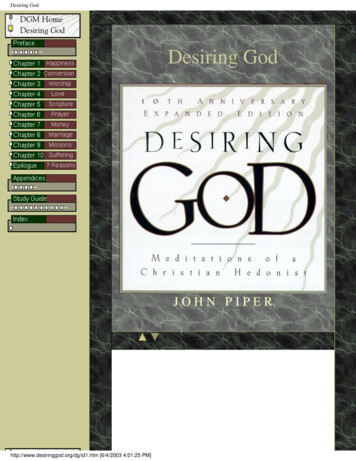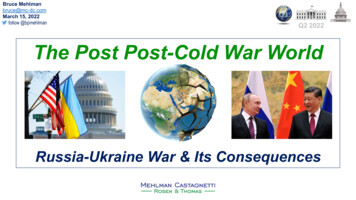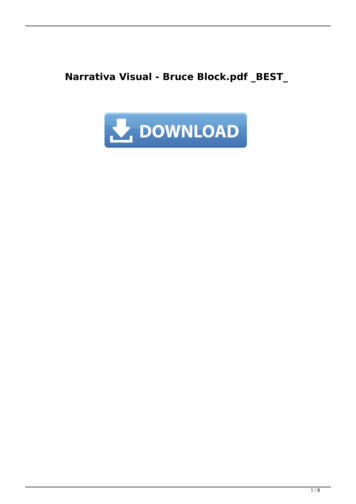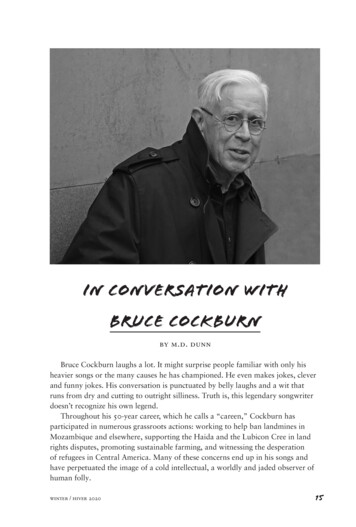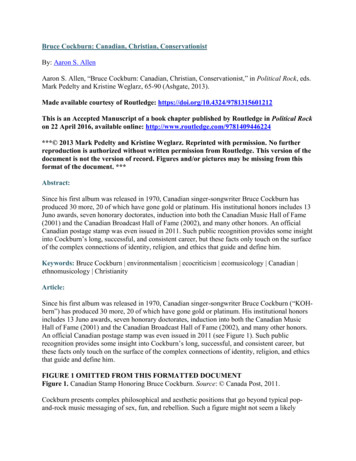
Transcription
Bruce Cockburn: Canadian, Christian, ConservationistBy: Aaron S. AllenAaron S. Allen, “Bruce Cockburn: Canadian, Christian, Conservationist,” in Political Rock, eds.Mark Pedelty and Kristine Weglarz, 65-90 (Ashgate, 2013).Made available courtesy of Routledge: https://doi.org/10.4324/9781315601212This is an Accepted Manuscript of a book chapter published by Routledge in Political Rockon 22 April 2016, available online: http://www.routledge.com/9781409446224*** 2013 Mark Pedelty and Kristine Weglarz. Reprinted with permission. No furtherreproduction is authorized without written permission from Routledge. This version of thedocument is not the version of record. Figures and/or pictures may be missing from thisformat of the document. ***Abstract:Since his first album was released in 1970, Canadian singer-songwriter Bruce Cockburn hasproduced 30 more, 20 of which have gone gold or platinum. His institutional honors includes 13Juno awards, seven honorary doctorates, induction into both the Canadian Music Hall of Fame(2001) and the Canadian Broadcast Hall of Fame (2002), and many other honors. An officialCanadian postage stamp was even issued in 2011. Such public recognition provides some insightinto Cockburn’s long, successful, and consistent career, but these facts only touch on the surfaceof the complex connections of identity, religion, and ethics that guide and define him.Keywords: Bruce Cockburn environmentalism ecocriticism ecomusicology Canadian ethnomusicology ChristianityArticle:Since his first album was released in 1970, Canadian singer-songwriter Bruce Cockburn (“KOHbern”) has produced 30 more, 20 of which have gone gold or platinum. His institutional honorsincludes 13 Juno awards, seven honorary doctorates, induction into both the Canadian MusicHall of Fame (2001) and the Canadian Broadcast Hall of Fame (2002), and many other honors.An official Canadian postage stamp was even issued in 2011 (see Figure 1). Such publicrecognition provides some insight into Cockburn’s long, successful, and consistent career, butthese facts only touch on the surface of the complex connections of identity, religion, and ethicsthat guide and define him.FIGURE 1 OMITTED FROM THIS FORMATTED DOCUMENTFigure 1. Canadian Stamp Honoring Bruce Cockburn. Source: Canada Post, 2011.Cockburn presents complex philosophical and aesthetic positions that go beyond typical popand-rock music messaging of sex, fun, and rebellion. Such a figure might not seem a likely
candidate to produce so many gold or platinum albums. What is it that audiences find socompelling? Do audiences care primarily about his sound—that is, his voice, arrangements,virtuosic guitar techniques, and so on? Or is it the political messages in his poetry?While tracing specific desires and reasons for aesthetic preferences of large groups is a slipperyendeavor, there is a more specific question that interests me here: how does Cockburn engagewith environmental issues and effect change? With regard to environmentally oriented popularmusic, David Ingram suggests that “Further research is needed in reception studies to investigatehow particular pieces of music have actually affected listeners, and whether they have played apart in organizations or subcultures involved in environmental activism” (Ingram 2010, 236).While this short study cannot claim to make definitive pronouncements about either popularmusic in general or Bruce Cockburn in particular, I do hope to offer some insights into how wemight understand him and how he engages with environmental issues.Environmentalism is not an isolated issue for Cockburn; rather, it is part of a complex ofconcerns for nationality, personal religion, and humanitarianism. Cockburn’s environmentalismis but one component of a broader expressive and activist agenda that links music and poetrywith issues of identity, belief, and stewardship. And if we are to consider how Cockburn is apolitical musician—how he and his music have changed the world for the better—then we shouldconsider his contributions in this ecological matrix.There are no comprehensive book-length biographies about Cockburn, although he is reportedlyat work on his own memoir. However, there is one master’s thesis in theology that takesCockburn as a topic (Olds 2002), and Canadian theologian Brian Walsh has written two booksabout Cockburn and religion (Walsh 1989, Walsh 2011). Cockburn has more often been thesubject of websites, magazine articles, and book chapters. The collaborative “Cockburn Project”website (cockburnproject.net) lists all the albums, their credits and lyrics, and many ofCockburn’s statements about each song from published songbooks and live interviews andconcerts, as well as other primary sources, such as Cockburn’s speeches and public writings. Ihave relied on many of the anonymous and credited submissions of fans to this website in orderto flesh out my knowledge of Cockburn and his works. Further, I was fortunate to discuss himwith various fans, including two that run popular websites on Cockburn and two Canadianmusicians who grew up listening to him, and their reflections have also contributed to myunderstanding and appreciation of Cockburn.Journalists, critics, and scholars have taken a variety of approaches to Cockburn’s career.Regenstreif (2002) sees Cockburn as being a spiritual and political songwriter. Adria (1990)traces Cockburn through his “adopt[ing], in turn, the personas of happy hermit, travellingtroubadour, Christian ecstatic and social critic.” Wright (1994), in charting changes innationalism among Canadian pop musicians in the 1960s through 1970s, locates Cockburn in thedynamic and often paradoxical relationship between musicians and Canada at this time. Rice andGutnik (1995) seek to demonstrate that Cockburn is an artist, as opposed to an artisan, and aneclectic Canadian one at that. They categorize Cockburn’s then career, from the late 1960s untilthe mid-1990s, into three phases: a first of bilingualism and national identity, a second of dancemusic and multiculturalism, and a third of world travel and north-south relations. Wright’s andRice and Gutnik’s nuanced analyses are useful contributions to the following biographical
overview, which situates his life and works in the context of Canadian identity, Christian belief,and conservation ethics. This last is of most interest to me, and so I also provide an ecocriticalmusicological analysis of Cockburn’s songs in the pastoral mode.Canadian IdentityBorn on May 27th, 1945 in the Canadian capital of Ottawa and active since the late 1960s,Cockburn has come to be identified as quintessentially Canadian. After his string of successfulalbums in the 1970s, he was awarded in 1983 the Order of Canada, the second highest honor forCanadian civilians; in 2003 he was promoted to Officer of the Order. In 1984, one critic referredto Cockburn as “Canada’s musical consciousness” (in Rice and Gutnik 1995, 249). In 2011, theCanada Post Corporation created a stamp of Cockburn to honor his lifetime of achievement:against a backdrop of ten of his song titles is a black and white image of his bespectacled visagenext to the insignia of the Order of Canada. The stamp presents Cockburn as an icon of Canada.Although he does self-identify in practice, if not always in word, as Canadian, Cockburn doesnot wrap himself in the maple leaf flag. Fans and critics regularly identify him as Canadian.Although a certain amount of contrast to American culture constitute his Canadian-ness,Cockburn goes beyond simple contrast to construct his national identity but does not becomenationalistic. In 1971 he said:I’m a Canadian, true, but in a sense it’s more or less by default. Canada is the country Idislike the least at the moment. But I’m not really into nationalism—I prefer to think ofmyself as being a member of the world The Canadian music scene is not yet as rottenas the US scene. But it’s showing signs of catching up. (Quoted in Wright 1994, 287)Cockburn’s life in the intervening four decades has substantiated that claim. He has maintainedhis principal residence in Canada, moving from the outskirts of Ottawa to Toronto (1980) andthen to Montreal (2001)—rather than moving, say, to New York, Nashville, London, or Paris.Furthermore, Cockburn has consistently published his English lyrics with French translations(and the occasional French language song, such as “Badlands Flashback,” Dancing in theDragon’s Jaws, 1999); he has also written songs mixing English verses and French choruses, aswith “Prenons La Mer” (Further Adventures Of, 1978). In doing so, Cockburn espouses theofficial bilingualism of Canada, which has been regulated by federal law since 1969, but whichwould not normally apply to poetic song lyrics. He has recorded exclusively with one Canadianlabel since his start, Bernie Finkelstein’s True North, and has remained dedicated to the labeldespite changes in ownership.Cockburn has traveled the world extensively for tours and social causes, particularly through theUnitarian Service Committee (USC) of Canada. In addition to travel to promote his albums,receive accolades, and make appearances at prestigious venues (for example, Saturday NightLive, Madison Square Gardens, and so on), he has also made numerous international tours:Central America (1983), Australia and New Zealand (1983), Europe (1986), US Solo (1988), andso on. Furthermore, he has traveled extensively for humanitarian work: Nepal (1987 and 2007),Mozambique (1988 and 1995), Cambodia and Vietnam (1999), Baghdad (2004), and so on.
In the latter half of the 20th century, the idea of a Canadian nationalist artist was a contestedcategory, particularly in the realm of rock, pop, and/or folk music and particularly in the periodafter the Canadian Centennial of 1967. Robert Wright (1994) has explored the nationalistdilemma English-Canadian musicians faced ca. 1968–72, particularly regarding tensions with themainstream American pop music industry. This period saw a flourishing of accessible Canadianpopular music, but it “had less to do with homage to Canadian geographical and historicallandmarks than with the extent to which it had co-opted and preserved an earlier American folkprotest tradition” (Wright 1994, 284). Many, including Cockburn and Gordon Lightfoot, NeilYoung, Joni Mitchell, et al., both protested against and participated in that American system.In addition to the multicultural policies of the federal government of Canada, led by PrimeMinister Pierre Trudeau, one common element for Canadian musicians of this period was a rulepromulgated by the Canadian Radio-Television and Telecommunications Commission (CRTC).Starting in January of 1970, 30 percent of all programming had to be written, performed, orproduced by Canadians. Also beginning in 1970 were the Juno Awards, named for CRTCpresident Pierre Juneau and based on Canadian content criteria. According to Wright,“Paradoxically, however, the CRTC ruling was problematic for Canadian performers. Perhapsunexpectedly, it fostered a keen and what would become an enduring awareness in the Canadianpop music industry of the limitations of nationalism.” Canadian musicians wanted to avoidappearing nationalist or sanctioned by their government, and many felt “constrained rather thanliberated” (Wright 1994, 286–8).The American folk music scene burgeoned in the 1960s and 1970s, which is just the time whenCockburn developed his style and approach to composition and performance. Between 1964 and1966, he studied at the Berklee School of Music in Boston; he did not graduate but did receivethree honors from this institution: their Songwriter’s Award (1988), Distinguished AlumniAward (1994), and an Honorary Doctorate (1997). Cockburn’s time in the United States studyingand traveling influenced his musical style and ideology. The mainstream American musicindustry of the 1950s strove to be apolitical. By the time of the Vietnam War and the folk musicmovements of the 1960s and 1970s, however, music took on greater political resonance,particularly in the hands and voices of Pete Seeger and Bob Dylan, who were particularlyinfluential for many Canadians, including Cockburn (Wright 1994). Canadians drew onAmerican music industry, styles, and artists in a manner resembling Bloom’s (1997) “anxiety ofinfluence”: it is neither simple copying nor complete avoidance, but rather a sophisticated styleof learning that builds on and changes the model. In this case a Canadian might either succumbwillingly or try to avoid completely the American model; more likely, he might want to avoid itbut be helpless to do so.Cockburn avoided mainstream American styles and the strictures of the pop market, but henevertheless learned stylistic and political lessons from American folk music. As Cockburnexplained in 1972:I think a lot of the songs that are being written are distinctively, if not obviously,Canadian. Playing something close to American music but not of it. I think it hassomething to do with the space that isn’t in American music. Buffalo Springfield had it.Space may be a misleading word because it is so vague in relation to music, but maybe it
has to do with Canadians being more involved with the space around them rather thantrying to fill it up as Americans do. I mean physical space and how it makes you feelabout yourself. Media clutter may follow. All of it a kind of greed. The more Canadiansfill up their space the more they will be like Americans. Perhaps because our urbanlandscapes are not yet deadly, and because they seem accidental to the whole expanse ofthe land. (Quoted in Wright 1994, 292)In this statement we can see the complex relationships here: American music, or “somethingclose to” it, is okay but Canadians should emulate Americans less. Furthermore, the urban-ruralcontrast is important for Cockburn’s reception as Canadian and for his conservationist ideals.Cockburn’s year in Boston and other travels in the US led to his distrust of America. He feltuncomfortable being there, believed the politics and bellicose positions of the government to bereprehensible, and found the urban decay and violence disturbing. At the same time, however, heknew Canada did not have all the right answers; it was just different. Cockburn and otherCanadian musicians who had similarly conflicting impulses did not express a simple antiAmericanism; rather, as Wright concludes, “they were able to judge life in America from thevantage point of the outsider and the insider simultaneously, blending toughness and sympathy ina way that was unique to the American music scene” (294). Canadian musicians like Cockburncombined numerous factors—a distaste for American society and a deep understanding ofCanada, an engagement with policies such as the CRTC’s nationalism and Trudeau’smulticulturalism, and an appreciation of America’s musical styles and protest singers—to createthe Canadian national folk style of the 1960s and 1970s.Simultaneously despite and because of his relationship with the United States, Cockburn’s stylewas influenced by American folk styles of the 1970s: Appalachian music, white gospel, blues,jazz, and so on. Cockburn picked up some elements of his early acoustic guitar picking stylefrom the American bluegrass musician David “Fox” Watson; such influence can be heard onBruce Cockburn (1970) and High Winds, White Sky (1971). The title track of Sunwheel Dance(1971) is an instrumental piece that reflects Cockburn’s learning from Watson. Cockburn’salbums Night Vision (1973) and Salt, Sun and Time (1974) are infused with jazz chords, jazzinstruments (for example, clarinet), and extended jazz solos. He first recorded using electricguitar, electric bass, and synthesizer in “It’s Going Down Slow” (Sunwheel Dance), in which hisdistorted blues guitar style reflects the war protest of the text (Rice and Gutnik 1995).If there are distinctive so-called “Canadian” elements in Cockburn’s music, they might be tracedto some general aspects of English folk songs or, more specifically, native Canadiansthemselves. Cockburn references First Nations peoples in text, as in his lament for their beingimprisoned (“Gavin’s Woodpile,” In the Falling Dark, 1976), and in music, as with a refrainusing the non-lexical vocables common to many First Nations’ songs in “Red Brother, RedSister” (Circles in the Stream, 1977) (Rice and Gutnik 1995). The texts of two songs included onthe 2011 Canada Post stamp also resonate with Canada. “Coldest Night of the Year” (on Resumeand Mummy Dust, both from 1981) cites “the Scarborough horizon” and “Yonge Street,” bothwell-known features of Toronto. Paradoxically, “Tokyo” (Humans, 1980), which was writtenafter Cockburn’s tours in Japan, also resonates with Canadianness: the lines in the verse,
“Tonight I’m flying headlong/To meet the dark red edge of dawn,” and in the chorus, “OhTokyo—I never can sleep in your arms,” both indicate going home, eastward to Canada.Beyond American and Canadian styles and references, Cockburn draws on many national andinternational influences, including those he experienced close to home in Toronto. His father wasa doctor and went to Europe after the war, but that perspective was not the only thing thatinfluenced young Bruce. The Trudeau government (1968–79 and 1980–84) promoted amulticulturalism that impacted the cultural fabric of major urban centers. This multiculturalism isreflected in Cockburn’s music, and it is perhaps this international musical language that mostidentifies Cockburn as Canadian.Cockburn included Caribbean calypso in “Burn” (Joy Will Find a Way, 1975) and reggae in“Wondering Where the Lions Are” (Dancing in the Dragon’s Jaws, 1979), “Rumours of Glory”(Humans, 1980), and four of the nine songs on Stealing Fire (1984). Stealing Fire includes atleast two songs—both on the 2011 Canada Post stamp—that were inspired by Central Americancrises: “If I Had a Rocket Launcher” is stifled anger at the fate of Guatemalans along the RioLacantún (bordering the state of Chiapas in Mexico), while “Lovers in a Dangerous Time” isabout finding beauty despite the tenuousness of life. Songs on Stealing Fire use various LatinAmerican instruments and devices picked up on Cockburn’s 1983 tour. Cockburn continued theuse of Latin American instruments on World of Wonders (1986), about which he admitted: “It’strue that the new songs have a more consciously internationalist sound, but that has less to dowith those particular styles than with the fact that I come from a country with no musicaltradition at all” (in Rice and Gutnik 1995, 250).This sentiment is one Cockburn also expressed some ten years earlier, when he stated that, “Witha few minor changes, I ripped off an Ethiopian thumb harp piece to make the guitar part” for thetitle track of Joy Will Find a Way (1975) (in Rice and Gutnik 1995, 248). On that same albumare two pieces, “A Life Story” and “Arrows of Light,” that reference North Indian classicalmusic. An earlier song, “Shining Mountain” (High Winds, White Sky, 1971), evokes a Persianavaz and Turkish and Balkan meters: the unmetered introduction is played on a hammereddulcimer, a cousin of the Persian santur, while the metrical groupings of the song shift betweentwo and three, referencing Turkish and Balkan traditions. Middle Eastern music is also cited in“Sahara Gold” (Stealing Fire, 1984), and Klezmer gets a nod in “Anything Can Happen” (BigCircumstance, 1988) (Rice and Gutnik 1995).In more recent works, such widespread interests continue together with Canadian references.“Each One Lost” (Small Source of Comfort, 2011) is about Canadian soldiers killed in theMiddle East; together with appropriate solemnity there is anger in the verse: “ all theseinventions/arise from fear of love/and open-hearted tolerance and trust” which is followed by“Well screw the rule of law/we want the rule of love/enough to fight and die to keep it coming.”Death and potential death (by suicide, perhaps) is explored in “Anything Can Happen” (BigCircumstance, 1988), in which the opening verse references the Bloor Street viaduct in Toronto.Numerous albums and live performances include guest appearances by Americans Bonnie Raitt,Ani DiFranco, and many other accomplished musicians. Breakfast in New Orleans, Dinner inTimbuktu (1999) references its two cities verbally and sonically: lyrics refer to Chartres Streetand Kaldi’s Coffee House in “When You Give It Away,” and jazz and blues inspired “Down to
the Delta.” Various songs on Breakfast also use non-Western instruments: “Deep Lake” uses adilrubā, a fretted string instrument resembling an Indian sitar but played with a bow; and“Mango,” “Let The Bad Air Out,” and “Use Me While You Can” all include a kora, a 21stringed bridge harp of the Mande people of West Africa and, specifically, of Mali, in the centerof which is the city of Timbuktu. In “Tibetan Side of Town” (Big Circumstance, 1988), variousscenes from Kathmandu are described. On the instrumental “The End of All Rivers” (Speechless,2005), Cockburn plays Tibetan bowl and Navajo flute. You’ve Never Seen Everything (2003)uses recordings of frogs from northern Zambia. And Cockburn goes beyond just non-Westerninstruments to demonstrate a broad aesthetic palate: Life Short, Call Now (2006) incorporates astring orchestra, and an instrumental on that album, “Nude Descending a Staircase,” begins withrandom radio static.By synthesizing an entire world of sound, Cockburn was being distinctly Canadian. Hismulticultural musical references reflect the politics of Canada from the 1970s to the 1990s,particularly under the internationalizing Trudeau government and particularly in Toronto. Ratherthan settle into a comfortable career writing love songs or Christian music in a system that couldguarantee airplay for a Canadian musician, Cockburn expanded his horizons for artistic andpolitical reasons, all the while not losing site of his home and native land. Fans report a certainkind of nostalgia with Cockburn’s music. In part, this stems from his long career of makingmusic and from many fans that have followed him for decades; but it also may relate to abroadening of cultural horizons that came with being a Canadian. While Cockburn could haverested on his domestic laurels and reputation as a nationalist artist, his broader outlook made himmore a citizen of the world.Christian SpiritualityCockburn wears his religion on his sleeve, which may seem unusual for a musician not in the“Christian Rock” category. He is neither a fundamentalist, nor an evangelical, nor a mystic;rather, he is an open and committed Christian, one who does not easily fit into simple categories.Cockburn’s beliefs have been the subject of intense study and interpretation (Olds 2002,Regenstreif 2002, Walsh 1989, Walsh 2011), and I do not intend to expend much further energyon the matter. My goal is, rather, to situate his spirituality as one element of the complexpositions he espouses and presents to audiences; moreover, as many fans attest, there are variousways to interpret and categorize the issues in his songs, and Christianity is but one. Cockburn’sspirituality mutually reinforces and is reinforced by both his global perspective as a Canadianand his conservation ethics. Together, these forces fuel Cockburn’s politically informed music.An important question here is: what, and who, defines the “Christian Rock” category? Thestandard musicological source for an answer, the venerable Grove encyclopedia, does notprovide a subject entry on that or related categories, nor does it provide an entry on Cockburn.One popular website (www.drindustrial.com) that bills itself as “the ultimate online Christianrock CD database” makes no mention of Cockburn. The leading music industry trade magazinein the USA, Billboard, does include two charts, “Christian albums” and “Christian songs,” whichuse data from Nielsen SoundScan and Nielsen BDS, respectively, to provide rankings. ButCockburn has never appeared on these charts, although he has appeared on other Billboard charts(see Table 1). Apple’s iTunes has one relevant category, “Christian & Gospel,” but it includes
only one song by Cockburn: “Strong Hand of Love” on the compilation album Strong Hand ofLove: A Tribute to Mark Herd (1994), which includes 16 other artists or groups. Twenty-sevenof Cockburn’s albums instead appear in the iTunes “Singer/Songwriter” category.Table 1. Cockburn on Billboard Charts (from www.billboard.com, accessed 27 December 2011)Album/ “Song”Small Source of Comfort (2011)Speechless (2005)“If a Tree Falls” (1988)“Wondering Where the Lions Are” (1979)“A Dream Like Mine” (1990)Stealing Fire (1984)“If I Had a Rocket Launcher” (1983)World of Wonders (1986)Dart to the Heart (1994)The Charity of Night (1996)Big Circumstance (1988)Chart NameFolk Albums (2011)Jazz Albums (2005)Alternative Songs (1989)Hot 100 (1980)/AdultContemporary (1980)Alternative Songs (1991)Billboard 200 (1985)Hot 100 (1985)Billboard 200 (1986)Billboard 200 (1994)Billboard 200 (1997)Billboard 200 (1989)Peak on Chart7142021/22Time on Chart3 weeks17 weeks8 weeks17 weeks/13 weeks227488143176178182––15 weeks3 weeks7 weeks2 weeks1 week7 weeksCockburn may not be presented as a “Christian musician,” yet he self-identifies and isrecognized as a Christian and as a musician. This is itself the most telling aspect of his religiousworldview: open and committed, yet not easily categorized. A variety of experiences led toCockburn’s eventual realization of his faith, and both biographical context and poetic textscontribute to understanding how he presents his ideas.To please his Presbyterian grandmother, the Cockburn family, of Scottish descent, he attendedthe United Church (Adria 1990, 86). But he had no moment of conversion; rather, his realizationwas gradual. As he explained in 2002:I didn’t grow up in a religious household. We were exposed to the imagery ofChristianity. We went to Sunday school when we were little, that sort of thing. But it waspurely for social reasons and not out of a deep faith on my parents’ part. I first becameaware of the need to pay attention to the spiritual aspect of life in high school when I wasreading beat literature. I got introduced to Buddhism through that. It seemed to makesense to me. Later on, I flirted with a few different things. I went through a period ofbeing interested in the occult in its various aspects and gradually evolved through all thatinto becoming more and more like a Christian. I became so much like a Christian that Istarted calling myself one. (In Regenstreif 2002, 36)His songwriting relies on his faith as much as other experiences of his life:I think it’s sort of the job of an artist to translate what we can understand of life intowhatever form you’re working in and that includes all aspects of life: the political, theromantic, the sexual and the spiritual are all fair game for subject matter for songs.Spirituality is central to everything in existence. It’s central to my understanding of theworld and therefore affects what goes into the songs a lot. (ibid.)Cockburn’s musical education did not emphasize religion; rather, as a teenager he supplementedhis formal studies in clarinet, trumpet, piano, guitar, and composition with his own studies of
jazz guitarists (Herb Ellis, Gabor Szabo), jazz pianists (Oscar Peterson), and pop and rock music(Les Paul, Buddy Holly, Richie Valens, Elvis Presley). Late in his teen years, before and amidsthis semesters at Berklee, he got into folk, particularly the music and poetry of John Lennon andBob Dylan (Adria 1990, 86–7). Moreover, blues guitarist Mississippi John Hurt was a greatsource of inspiration for Cockburn, and he contributed two pieces to the compilation albumAvalon Blues: A Tribute To Mississippi John Hurt (2005).Cockburn says that solitude is a necessary element for his creativity. Reading Beat works, suchas Kerouac’s On the Road, and traveling in Europe and the USA encouraged Cockburn’sintrospectiveness. The young Bruce sought out solitude as a way of coping with his sensitivity towhat he termed “another side of life.” Myrna Kostash, an early chronicler of Cockburn,described him in the early 1970s as “still playing the part of the wilderness poet.” That desire forsolitude was personal, spiritual, and musical: his reliance on an ever-changing group of“mercenaries” as bandmates fits into that trait. Cockburn prefers to not work with the samemusicians too much; his four decades of albums and tours demonstrate that, but he also says thathe does not want to “settle in to certain musical habits” because he needs “to be shaken up everynow and then” (in Adria 1990, 85–7). After studying at Berklee and returning to Ottawa,Cockburn was involved in a number of bands, including The Esquires, The Children, and Threesa Crowd. But by 1969, he went solo full-time and played at the Mariposa Folk Festival and inpopular clubs in Toronto, Ottawa, and Montreal. During this period Cockburn connected withBernie Finklestein, who is still his manager today (Regenstreif 2002).Cockburn expressed his ideas of being solitary in the love song “Loner” from Inner City Front(1981):I’m a lonerWith a loner’s point of viewI’m a lonerAnd now I’m in love with you 1He even switched into Spanish for part of a verse to establish a bit of distance from his otherwisemostly French-Canadian or English audiences (or, perhaps, the language shift was intended assome intimate message). In “Use Me While You Can” (1999), Cockburn reflects:I’ve had breakfast in New OrleansDinner in TimbuktuI’ve lived as a stranger in my own house, tooDark hand waves in lamplightCowrie shell patterns changeAnd nothing will be the same again 2This verse also provides the line for the album as a whole, and it illustrates his loner status,distance, introspection, and role as a citizen of the world.12Written by Bruce Cockburn. Used by permission of Rotten Kiddies Music, LLC c/o Carlin America, Inc.Written by Br
Cockburn developed his style and approach to composition and performance. Between 1964 and 1966, he studied at the Berklee School of Music in Boston; he did not graduate but did receive three honors from this institution: their Songwriter's Award (1988), Distinguished Alumni Award (1994), and an Honorary Doctorate (1997).



